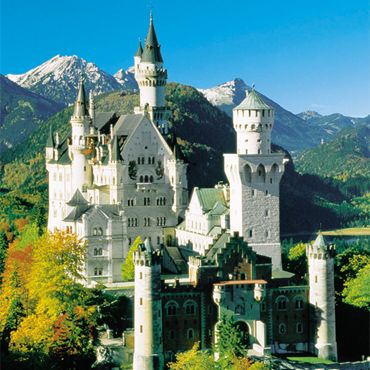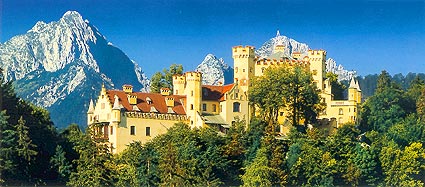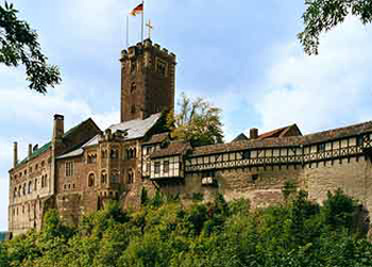The Romantic Road
Thursday, December 15th, 2005It’s been almost two months since we left Germany and many so-called friends have been sending me nasty emails. Apparently some of you have an unquenchable thirst for the dirty details. So here it is at long last, hope it satisfies those cravings. Enjoy!
On the 25th of September Lisa and Graeme said ciao to good friends Dietrich, Mike, Frank and Lars, who would be missed but not forgotten. With only ourselves for company we raced away from Munich, escaping the blurry haze of Octoberfest, and headed south on the Autobahn towards Garmisch-Paterkuchen. Our chariot for the next seven days would be a newish Volkswagen Golf, replete with satellite navigation system. The rental agency failed to mention that the navigation consol spoke only Deutsch, or maybe we failed to ask., whatever the case Lisa did an admirable job without it. Thank you co-pilot!
Now not many of you have likely heard of Garmisch-PitterPatter, understandable, though I strongly advise each of you to stop what your doing and go write it down in that journal of places you must visit before you die. The town is situated an hour’s drive from Munich on Germany’s southern border with Austria, where the Alps suddenly spring up from the flat green countryside beneath to form immense limestone spires. It’s an amazing drive. The peaks are visible from miles away but just seem to grow and grow as you approach until they tower over you on all sides. Temperate evergreen forest grows in the valley and on the lower slopes, but higher up the hillside sheer rock emerges in vertical walls extending beyond site. The trees and mountains begin to crowd in closer to the road, which follows a route next to a fast flowing river. The valley abruptly ends in a wall of rock but the road continues underground for a mile or so. Then voila, you drive out into the daylight of a Bavarian wonderland. A wide forested valley dotted with small farms unfolds before you and at its far end is Garmisch-Pattermeister. Imagine Whistler village minus the fast food outlets and towering hotels and with a thousand times more authentic charm. The streets are clean and lined with cool shops and restaurants. Bavarian architecture is everywhere and many buildings are hundreds of years old. It’s all very compact so Lisa and I managed to walk through the whole town in a couple hours. And the best part is the mountains ,which offer up outdoor distractions in every direction.

On Tuesday we hiked to the base of the Zugspitz, Germany’s highest peek. A cogwheel train shuttles passengers up the mountain, through a 5 mile tunnel and onto the glacier behind the peek. From there you can climb another mile to the summit or chow in the restaurant. We did neither as the weather was cloudy and they wanted 40 euros to ride the train. I’m still kicking myself for being cheap. Our first night in a German hostel was great and at breakfast the buffet table was loaded with fruit, cheese, fresh rolls and salami, an obvious recipe for take-away lunch. As it would turn out, every German hostel provides identical breakfast, which means a full belly in the morning and some sandwiches for later on. Definite plus!
As I mentioned, Garmisch- Patterplatter is next to Austria, so it made sense to spend a night in Arnold Swarzneggers home town of Reutte. As a side note, since becoming the governor of California, Arnold’s stardom has reached unimaginable heights in his homeland, the guys a god. Our night in Austria is notable for cheap petrol and the oldest hostel of our trip, probably a 500 year old manor house. The following day we investigated the glowing UFO we’d stared at over a dinner (our first Turkish Doner in Austria, yum!). To reach its landing pad we took the most indirect route possible, somehow cruising into Italy than back through Germany to a parking lot 5 minutes away from where we began. Another 15 minutes of mountain climbing brought us to area 51, which turned out to be the ruins of a precariously perched mountain top fortress illuminated by spotlights during the night. It was a great reward with views in all directions, here’s a photo from on top.
From Austria we would head north towards Berlin, following the most scenic route available, The Romantic Road. The idea was dreamed up by the German tourism board as a way to steer travellers past the best in Bavaria. They placed road markers along 500 miles of scenic windy road in the lovely Bavarian countryside and gave it a cool name. The Romantische Strauss was born. Now I ask you, what Canadian couple wouldn’t want a bit of Bavarian Romance? For Lisa and I, it was a no-brainer.
Feeling flush with confidence after our mountain explorations we hooked up with the Romantische Strauss in Fussen, a town most notable for it’s medieval market and proximity to the two most famous castles in Germany, Neuschwanstein and Hohenschwangau. Though we visited on a Thursday in the off-season, the castle village was still bustling with tour groups. They story behind the place is interesting. King Ludwig II was born in Hohenschwangau with a silver spoon jammed in his gob. He grew up rich, slightly mad, and infatuated with swans (schwan means swan). His parents pad is a baroque masterpiece, sat on a small hill with fertile valleys to the north and west, Alps to the east and a beautiful lake to the south. Though castles had ceased to be a practical use of tax money, Mad King Ludwig decided one pimpy pad wasn’t enough, and in 1880 he started construction of his own masterpiece. Unfortunately for our schwan loving friend, his frivolous use of peasants hard earned cash failed to endear him to the locals and in 1886 the King was found floating face down in a schwan pond. But Germans being Germans they decided to finish what they started, thankfully for snow-white, whose Disneyland castle took inspiration from Neuschwanstein, which was finally completed in 1886 and has been a tourist magnet ever since. I’d love to show you a photo of the majestic tower or grand entrance hall, but sadly, our camera batteries went kaput at the worst possible moment, so here’s a some borrowed photos.


Back on the Romantische Strauss we headed north, leaving the Alps behind and entering a region of Bavaria loaded with history. Our route took us through villages that predate Canada by a couple thousand years. These small rural communities still thrive on farming, just as they did when the Romans built the first autobahns into this barbarian land. Not much of the Roman era remains visible, but medieval buildings and Christian architecture abound. It’s hard to communicate how tangible the history becomes, physical reminders are everywhere and the village of Nordlingen is a fantastic example. Nordlingen has 20,000 residents, most of whom still reside within the town’s 14th century walls. We arrived at midday and immediately set about walking the wall. It’s a perfect circle about 1 mile in diameter. In the 3 months since, we’ve visited a dozen walled cities and none of them have had better preserved walls. As a rule, city walls offer the best insight into the cleanliness of local inhabitants, at least when it comes to back gardens. Nordlingen’s were exceptionally tidy, though we wouldn’t fully appreciate this fact until a month later when we discovered the Welsh form of garden management. Anyways… at the centre of Nordlingen is St. Georg Kirch, a stone grey bell tower roughly 10 stories high. Can you guess who was eager to climb it and who was shit scared? Luckily I’m persuasive. Up we went and I have got to say that the German who constructed the staircase was either an absolute nut or short of proper tools, because worm eaten, left over lumber does not a solid stair make. Full credit to Lisa who not only ascended the stair of doom but actually poked her head out onto the blustery balcony, if only long enough for me to snap this picture:
And the Romantic road just kept rolling on…
Travelling in a rental car made it so easy, we could grab groceries from small Bakerei or Deli or SPAR markets (literal translation is CHEAP) and blast along in meaty cheesy chocolaty bliss. Our massive bags only needed to be carried from car to hostel and back again. The weather was never an issue cause clothes were close at hand. And on top of that, German radio is hilarious, there’s all these really awful 80’s tunes mixed with the occasional schlager anthem. The best description of schlager is home grown German folk rock that everyone sings along to. There exists entire sections of Hamburg devoted to Schlager dance clubs – it’s an absolute riot, but I’m getting ahead of myself now.
The last two Bavarian cities worth note are Rothenburg and Bamberg, both gems of medieval design that avoided bombing in the war. It was mostly the larger industrial cities that received the brunt of Allied airborne destruction, so little pretty towns are the best reminder of the glory of Charlemagne and the Holy Roman Empire. In Rothenberg we found a 800 year old prison that now houses the museum of torture, which has a massive display of authentic medieval torture machinations; things like a rack for stretching the human torso beyond its legal limit, or finger screws to crush one’s nails, or rectal pikes coated in pig fat, its grisly stuff but disturbingly fascinating. Not all the methods seemed so bad. I personally wouldn’t mind if they brought back the pillory. It’s a metal cage in which miscreants are locked naked for a few days, preferably in the town square, allowing citizens to poke, tickle and pelt with rotten fruit the offender. Or, if the citizens are too sedentary to inflict punishment, a convict may simply have his bare feet shackled, coated in salt and offered up to a coarse tongued goat. From torture to towers, our next stop was Bamberg with its massive Dom Cathedral. Hopefully the photo gives you an idea of the awe-inspiring size of the Bamberg Dom. It’s immense and the interior is laden with gold gilding, intricately carved crypts and vivid stained glass. I’d have loved to show you but my travelling partner felt interior photos would be inappropriate.
Before I forget I should mention our Romanian guardian angle, Alex the Pilgrim. Alex appeared in a time of great need, after being shut out of a hostel in Wurzburg and needing to reach the hostel in Schweinfurt prior to closing. Navigation to said hostel was a complete gamble, one we were likely to lose, until on the first road out of town I noticed a cheerful chap on the side of the road holding aloft a cardboard sign which read Schweinfurt. Apologies to Lisa’s parents for breaking a golden rule, but this hitchhiker was too timely to pass up. Not only did Alex speak impeccable English and know the way to Schweinfurt, but he had great anecdotes from his around the world pilgrimage. He’s even visited Thunder Bay Ontario, an obvious city of theological significance. We had such a good time with Alex that it was easy to accept his dinner invitation. Food from a stranger, I guess that’s Golden Rule number two broken, sorry Mrs. Hicke! We met his Romanian Dad, who like most Dads was immersed in a football game, and he fed us some delicious traditional cabbage soup with whole Paprika on the side and a tall bottle of beer. Our guardian angle then guided us directly to the hostel, way late but well nourished. Thanks Alex!
Well were moving along pretty well here. Bavaria took 5 days, 200 photos, 600 miles, two tanks of petrol and about 1800 words. So go grab yourself a starbucks and settle in, we’re off to Thuringia and it’s famous Bratwurst! If you’re following along by map you will notice our route went south to the border, then a little west to Fussen and up along the Romantic Strauss northwards to the Thuringian border. At this point we are almost halfway to Berlin, near the geographical centre of Germany, but as soon as we enter Thuringia we step behind the Iron Curtain. Prior to division this province was in many ways the cultural centre of the Germanic empire. The city of Weimar, which we spent a lovely morning wandering, was the birthplace of Johanne Wolfgang von Goethe, unquestionably Germany’s finest thinker, playwright, artist, philosopher, dramatist – I’m sure I’m missing some – all around dude. Than the Russians took over and the place stagnated for 50 years. But Weimar got off lucky. Bigger cities, like Liepzig, Erfurt and Dresden got bombed to shit and subsequently rebuilt along communist lines, resulting in grim grey skylines ala View Street Towers times a hundred. Yet sections of these once glorious cities managed to survive the pummelling so you get chunks of medieval beauty casually thrown together with painfully plain concrete monsters. The contrast between east and west German reconstruction is immediately apparent once you cross the former border.
Nonetheless, we were continually amazed by the beauty of the German landscape. A great deal of Thuringia remains covered in forest, not dense BC forest but a more open variety that is very appealing for day hikes. This is especially true for the hills around Eisenach which harbour a hilltop paradise called the Wartburg. This ancient castle has panoramic views with forested trails stretching miles in all directions. The hike to the top is an effort in itself (which is why there’s a shuttle service for old folk) but once there it’s like entering the pantheons of heaven. They’ve even got real white doves hovering around, yet no poop to trod in, how does that work? It’s a UNESCO world heritage sight, mainly because it was here that Martin Luther translated the Latin bible into local vernacular and spawned the first revolutionary split from the Catholic Church. Lisa felt a kinship because she goes to a Lutheran Church. I liked the doves.

Not far up the road is Erfurt, where we got this snazzy photo of a big Ferris wheel. Many German cities have there own Octoberfest parties, Erfurt’s was at the centre of town immediately in front of a massive old Cathedral which provided a cool contrast to the buzzing lights and sounds. We were hanging out on a Friday evening and spotted many teenage Erfurtians getting plastered on wobbly pops than strapping themselves into spinning arm thingies. Made me homesick and nostalgic all at once.
The other memorable feature of Erfurt was the Hostel, well, more specifically the hostels bathroom. I think the building was a former communist dairy farm.. Our little four bed dorm had an ensuite bathroom which measured about 300sq.ft. and was all cement and stainless steel with a industrial strength shower nozzle at the far end, I’m sure it was originally intended for hosing down farm animals. It blasted sore muscles into submission but was a hell of a long walk back to your towel.
Our final stop on the way to Berlin was Liepzig, where we visited a sobering museum about the rise and fall of Nazis and the post-war era. It set the tone for what was to come. For the next seven days we would be living in Berlin, walking its streets and soaking in the atmosphere. I can’t imagine another city on earth with such a schizophrenic past and such a promising future. But we’ve gotta get there first. Our rental car is do back at 4pm, it’s taken us twice as long as expected to escape the traffic insanity of Liepzig, which leaves us 2 hours to cover 200 miles and reach the centre of a city with 3.5million inhabitants. Rather then bother with the math, I just hopped on the autobahn and, for the first time all trip, staked my claim in the far left lane. It was truly liberating. Never before have I felt so close to flying. The little diesel Golf roared away at 4500RPM, Lisa dug her nails into the arm rest and we motored along at 190km/h. When 3:55pm rolled around there we were, shaking hands with the friendly Eurocar agent, taking a moment to pause and reflect on our trustworthy little Volkswagen, which sat ticking and clicking in the drive with 1400kms added to its odometer. Hurray for autobahns!
